I love Metroid II. I love the Metroid series. My first exposure to Metroid was on the NES. My brother’s friend owned it and I would sometimes tag along for the express purpose of playing Metroid. It was big and mysterious, completely captivating. But I didn’t own this game myself, and wouldn’t until years later when I started collecting. In fact, the first Metroid game I owned for myself, played through to the end, and loved every minute of it was Metroid II: Return of Samus.

If it seems like I often wax nostalgic over Game Boy, it’s because a lot of these games carry special meaning for me. IronSword may have been the first game I bought myself, but Metroid II was the first new game I bought for myself. I remember pouring over the Nintendo Powers covering this game. I remember calling Music World (Canadian readers will know) and getting it held behind the counter for me. I remember being proud to plunk down my money for it, first purchases like that have some kind of meaning to kids you know? I remember first setting foot into those eerie caves. I remember bombing every single surface as the Spider Ball. I remember the feeling of first encountering the Zeta and Omega Metroids.
Am I a bit tickled by nostalgia when it comes to Metroid II? Absolutely. But does it hold up when you take that nostalgia away? Again, absolutely.

Metroid II will get glossed over because it’s more linear than some Metroids, and because it’s on the Game Boy. But being on the Game Boy does not hurt Metroid II at all. Yes, Samus’ sprite is a little large to show detail, and yes not as much of the environment can be shown on that Game Boy screen. But generally I find enemy placement to take this into account, and I have rarely felt that I was running into an enemy I didn’t know was coming up. This is definitely a factor, but it’s not as present as you would think.
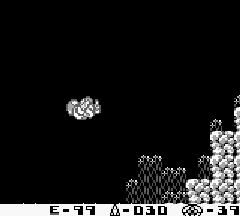
And for being a Game Boy title, Samus is remarkably acrobatic. Especially as you gain new items. You have control over her in midair, and everything feels solid. I’d say the only things that feel wonky are the Space Jump and Spider Ball, and that’s more a matter of learning how they work. With the space jump (Samus can jump multiple times in the air) you have to time your jumps properly or you will plummet (and cannot try again until you hit the ground) – but this is fine when you have learned the timing. As for the Spider Ball – which lets your Morph Ball cling to and move along walls – it’s more about what direction you need to press to proceed. You see, the Spider Ball requires input based on angle of the surface it’s on. So on the floor, you can hold right and it will trace a path up until you let go. How say you let go on a sheer vertical wall, you will now have to hold up to proceed because you stopped whereas if you didn’t stop you could have continued holding right.

But these are just quirks that are easily overcome and are not entirely frustrating. For the most part, Samus can move and respond with the best of them.
To address the concerns of linearity, yes this game is more linear than a lot of Metroid games. Samus is on an extermination mission. She must rid the Metroid homeworld, SR388, of all Metroid life. You will notice in the lower right corner of your screen there is a Metroid counter. The purpose of the game is to make this counter reach zero. Now, every area has a quota of Metroids you must kill. Once you meet quota, some acid will drain and reveal a new area so that you can continue on. Yes, this is even more linear than Fusion’s setup in ways. But each new section is fairly large and has a lot of places to explore. Some are even on the labyrinthine side of things unless you’re putting together a map. So within these areas you can generally get your gear and kill the Metroids in whatever order you see fit, so it’s not totally methodical.
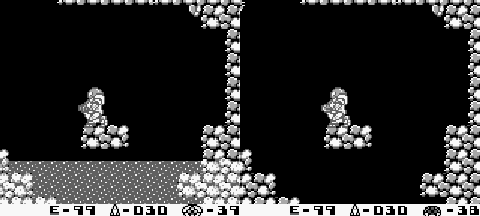
I like the pacing of the game. I like the linearity of the game. I’m not even going to try to defend the linearity based on Game Boy limitations. It obvious from playing this game and backtracking through it that it could have been presented differently. That it could have been more like the NES Metroid, it‘s a simple factor of removing the acid, combining some areas, and making new areas require items to reach. It’s a relatively small world, true, but I believe the pacing of the game is a thematic choice more so than a limitations choice. Where limitations come in might be the obvious placements of most power-ups. While some are well hidden, many are out in the open – especially missiles. This is okay every now and then, but when you have upwards of three upgrades in plain sight in the same chamber? Yeah, they could be hidden a little better.
But these extra missiles come in very handy. Missile refill stations are few and far between and the Metroids take a beating. Metroid II introduces a hierarchy of Metroids – mutations from the standard Jellyfish form. These come in Alpha, Gamma, Zeta, and Omega varieties with their Queen. The Alphas are easy – much easier than even a base Metroid, but the rare Zeta and Omega castes are pretty potent customers. And not only can they dish it out, they soak in so many missiles – they can be crazy durable so it is imperative you find the best ways to deal with them. And despite these dudes being the enemies you fight over and over again it doesn’t feel dull – you always wonder what caste is waiting down that corridor, or how can you use the different layout of this particular room to give me an advantage. It stays fresh.
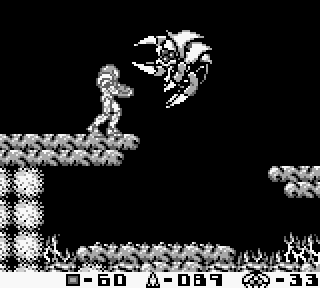
The Metroid series is known for its atmosphere. Most of the games present a very lonely scenario, Samus against the alien world. They’re moody, mysterious, and entrancing. Caves are dark, filled with strange life forms. Other caves are devoid of life, and its those tunnels that generate the most tension. Life varies with region, as does tile set – things stay fresh, and you can see the possible ecosystems here. And the environment works in the game’s favour too. Sometimes you will be clearing away sand only to reveal a Metroid lying in wait. And sometimes you will come across a Metroid only for it to evolve into its next stage. Gamma Metroid? Sorry pal – Zeta Metroid! And SR388 is littered with Metroid carcasses – the casings from which the mutants have sprung. While these casings certainly telegraph the appearance of a Metroid, you might not see the actual creature for a few screens.
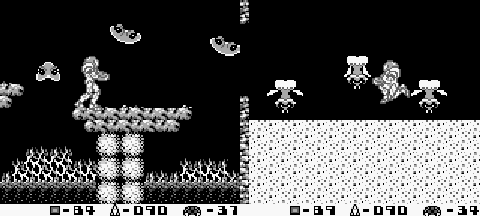

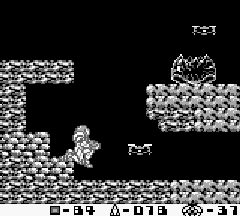
It puts you on high alert, a really effective way of creating tension within the Game Boy’s limitations. There are times when the game uses its own mechanics to play on your tension as well, but those situations are spoilers! Let’s just say Metroid II embraced its format and did great things with it.
Most of the sound design in Metroid II is set for atmosphere, as well. I can really only describe most of the background noise as “ambient weirdness” – some sections are largely silent with just an odd assortment of sounds. But you know what? It totally works. It makes you feel lonely, it makes SR388 feel completely alien. And when we can some actual musical pieces? Well, some of them are very memorable.
You know, if someone were to ask me what my favourite Metroid games was, I’d give the very typical response of “Super Metroid.” Super Metroid is one of the very few games I consider a “perfect” example of the medium. But if you were to ask me which Metroid game means the most to me – the answer is clearly Metroid II. But even taking away my personal history with the game, it remains a great entry in the series and one of the finest original Game Boy games. It built upon Metroid, and laid a lot of groundwork for Super Metroid.
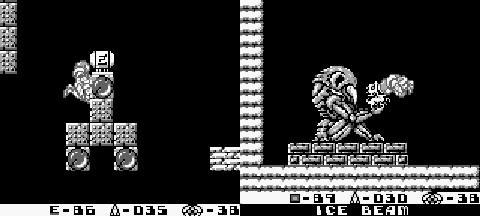
Over the years it’s gotten very little recognition, and I’d say it is totally underrated. I haven’t heard a lot of “black sheep” bullshit about this one – at least not as much as certain games in other series – but it isn’t a black sheep by any stretch of the imagination. If you’re going to pass over it because Game Boy entries are often “dumbed down” then please don’t – this is a game with some very smart choices. If you are immediately turned off by the more linear progression – don’t be, Metroid Fusion does this too and they are both proof positive that this kind of pacing can work well in a Metroid setting.
I’ll admit it, I am biased towards Metroid II. But I can recognize its faults and sing its praises just the same. It doesn’t just do things well for the Game Boy, it does things well for games in general. If you’re interested in the series, please don’t pass it up! Because Samus Returned, and the souvenir she brought you was one damn fine adventure.
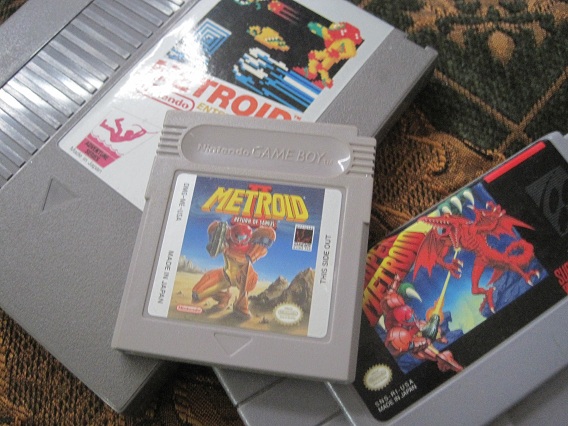

I still haven’t played this one, but that’s because I’ve been waiting for it to be remade ever since Zero Mission. I should probably just give in and go through it on GB, because there’s a great chance it’ll never be remade. :/
I’m pretty surprised it didn’t get the Zero Mission treatment, yeah. If you’re interested give it a whirl. It’s not long and a remake would be significantly different. For instance, ZM feels distinct from Metroid.
Well, the Zero Mission treatment happened by a fan! Plays pretty well, although I never played the original to compare.
http://metroid2remake.blogspot.com/
I’ve been hearing about this for years, so it was a pleasant surprise to hear it was finished. I’ve got it downloaded – sorry Nintendo, not this time – and I’ll be giving it a run through in the near future.
I’d recommend anyone who’s interested get it now before Nintendo makes it very scarce.